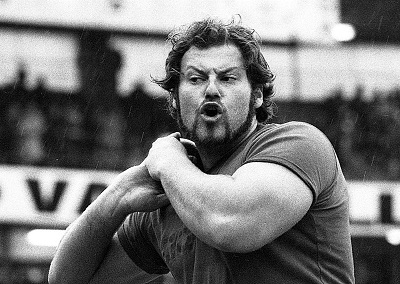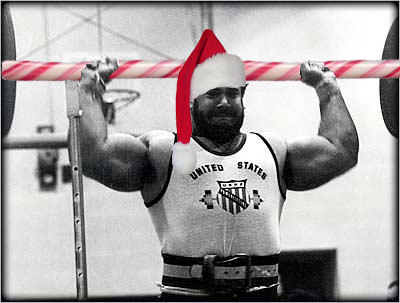I hope you are enjoying your holidays. If you trained through the the last week or so, then today is PR Friday. Otherwise share your goals for 2012. Let’s get to some questions. Unless otherwise noted, these are all from a recent thread on the Facebook Fan Page.

Spencer B.:
No gym access for two weeks…what should I do to maintain strength?
Dear Spencer,
Strength is a persistent adaptation and you won’t be losing much of it in a two week period. What you’ll most likely lose instead is your adaptation to the strength training. When you start training again you’ll be more sore than normal and your blood vessels won’t be used to the higher pressure of lifting. This is why I have always advocated having a light day when first getting back in the gym. Gradually increase the weight and stress over a few training sessions. If you had a significant layoff, then use the first week as a ramp up. It’s better to do to little than to do too much.
As for training or working out during your break, consider what physical attributes are lacking with respect to either overall fitness, athletic ability, or your specific goal(s). It may be a good time to work on muscular endurance via calisthenics (especially if you’re in the military and have to deal with PT tests). 99% of you need to work on mobility on a daily basis. Others could implement a sprint or conditioning program. Still, if strength and size are your primarily goal, you could do some sort of plyo calisthenics to focus on a speed and power element. For example, clapping pushups, speed pull-ups, and jumping squats could be done for sets of five to ten. Gymnastics type stuff can apply a strength training stress through a different angle or range of motion.
The overall point is that it’s not a long break and you won’t lose significant strength. Take care of your body and feel free to dabble in some un-used training modalities.
Kyle S.
1. What’s the recommended grip for the barbell row? I’ve been using bench width, but does it matter or is it just personal preference/which muscles you want to focus on?
2. Can you work on pull ups every day (or even multiple times a day), or is that too much stress to recover and adapt?
Dear Kyle,
1. For the same reasons as the bench press, the optimal grip will be similar to the bench in which the forearms are vertical and the elbows are over the wrists. This should be pretty much the same position on the bar (for me, it’s pinky on the rings). My opinion is that if you’re using the row for strength training purposes, use this efficient grip. If you’re going for a swollertrophy effect, do whatever you want. However, just like in the bench press, the most efficient method will train all of the musculature evenly. After a rowing session, my entire lat will be sore all the way down to my iliac crest. But I’m also sore in the upper middle back area where the middle traps and rhomboids are. It’s a very effective exercise. I don’t really see a point with messing with the grip until the hypertrophy is a primary goal. For example, the close grip bench is used to improve the lockout of a raw bench, but the close-grip row wouldn’t have utility to improve the performance of another lift.
2. Whether or not pull-ups can be done every day depends on what else is in the training program and what the trainee is adapted to. If you have a break from strength training, then daily pull-up training is probably fine if don’t do too much. If you’re only adapted to about 30 reps, don’t do 50. To be safe, just take a day of rest in between pull-ups sessions. However, if you’re using the frequency method then you’ll be doing a low enough number that can be done daily (yet you’ll obviously take a day or so of rest at some point in the week).
Blake S.
Taco Bueno vs. Taco Cabana vs. Taco Bell? Choose your answer wisely.
Dear Blake,
Dude, all of those fucking suck. I can’t imagine a shittier quality of food. You clearly like torturing your digestive system. For real, if any of you eat at these places regularly, you’re unconcerned with optimal performance, aesthetics, health, or…anything. I’d rather wax my grundle.
Justin C.
1. How many sets for volume day when moving squats to 3rm? I’ve been doing 8×3 but should I go to 5×3 with heavier weight?2. Also, in the book you mention a back off set on ID when using 3 reps or less, with your example being 15lbs lower than the PR attempt. Does doing this back off set change VD or not?
Dear Justin,
1. Don’t focus on the number of sets, but the overall volume. In the first year or so in the TM, we use a relative drop in volume as a stressor (this is explained in detail the second book). Your volume will be relative to what you’ve been doing recently, so it’s hard to answer this questions. You do not need to do eight triples on VDy just because you’re doing a triple on the ID. In fact, if you remember from the book, trainees should aim to get to 3×5 on the VD.
2. The back off set does not change the VD. The 15 pound drop is a minimum, so feel free to have a greater decrease. The point is to get some more reps with decent intensity.
Jason K.
I’m only just learning the Oly lifts. I want to get back to lifting heavy, but continue doing the Oly stuff at least twice a week. Any programming advice? FWIW, my best strength results have come from 5/3/1.
Dear Jason,
Now that I’m reading this again, I have no clue what you’re asking. You want to strength train but have been doing Oly stuff? You want to do an Oly program? It’s more important for me to point out that your clarification that 5/3/1 has given you the best results is irrelevant — unless you’re older. It works well with older guys because it doesn’t have a lot of volume so it prevents the hard-headed overtraining associated with the male gender. However, we don’t know anything else about you, specifically your training history and current state of adaptation. The fact that 5/3/1 “worked” for you may be because you were on shitty programs before doing it. Who knows, maybe you were doing CrossFit before it. In any case, saying that 5/3/1 gave you best results may or may not be relevant when committing to a programming style.
Marquis B.
Using 4×5 as a volume scheme on texas method. yes, no terrible idea?
Dear Marquis,
It depends. The current state of adaptation and the prior training history will dictate this. 4×5 may be useful in a portion of the program when the lifter is gradually reducing the volume over time, and it may be a bad idea when the lifter is adapted to lower amounts of volume. Folks, remember that context isn’t just relevant, but entirely necessary when trying to talk about programming.
Jose C.
Should someone who is only focused on olympic lifts bench press? My experience before focusing on olympic lifts was that I benched once or twice a week depending on programing and I had some bench strength but no mobility for overhead. Now after not benching for nearly 6 months, 135 feels heavy, but I am a lot stronger overhead than I have ever been and much more mobile. Able to snatch over bodyweight etc. Thoughts?
Dear Jose,
My first response is that 135 should never, ever feel heavy for someone who lifts regularly. Assuming you didn’t mean kilos, it’s okay, but I think that this weak bench is something to address. My next statement is objective and not mockery: If 135 pounds on the bench press is heavy, then you aren’t lifting enough in the Oly lifts to warrant a specific weightlifting focus that ignores the bench. Another way of saying is that you are pretty weak, so the bench press is something that will help you not be weak.
Anatomically, the bench press trains structures that will help improve your strength and stabilization in overhead movements. Consider a snatch in which the bar travels to far back. By having decent anterior shoulder and pec strength, you’ll be able to wrangle it back forward to it’s proper positioning. More strength around the shoulder means more stability when going overhead, even if the mechanics aren’t perfect.
My last point is that most famous weightlifting programmers from countries with better historic results in the Olympics and world competitions will have beginning lifters bench press. The frequency might range from once every seven to ten days. Eventually, an intermediate weightlifter will drop the bench in favor more weightlifting specific training, yet the bench can be useful early on in order to establish musculature and strength to support shoulder strength and stability.
Here is another point from Brent:
jose it depends on if you’re ok with some high school fuck head in junior varsity football benching more than you. that’s mainly why i bench. mobility shouldn’t be an issue if you have a resistance band and a lacrosse ball. it’s not necessary for oly but it absolutely doesn’t hurt and may even help if your shoulders need to be stronger. imo touching bottom with good external rotation and driving through the middle of a pr bench feels just as good as smoking the pull in a pr snatch and receiving it exactly where it needs to be
I still have some questions from the Facebook thread, but I’ll save them for another time. I used to care about answering all the questions, but then I took an arrow to the knee.
See you guys next year. And please…be safe.




